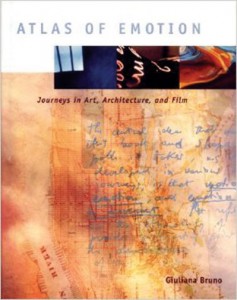 |
Giuliana Bruno. Atlas of Emotion: Journeys in Art, Architecture and Film. New York: Verso, 2002.
Giuliana Bruno challenged assumptions generally made about the relationship between geography, architecture and film. She shifted our attention away from the optic and reoriented our understanding of film and architecture towards the haptic—the sense of touch. Each section of this book builds Bruno’s argument for analyzing film and architecture through this lens that privileges spatial qualities and the sensory/sensual possibilities of the moving image or forms that configure architectural spaces. To animate her premise, she looks at the history of cinema, the place of travel in the context of film history, painting, maps and map making. In this interdisciplinary, non-chronological book, Bruno excavates geographic, domestic and familial landscapes spanning the last five centuries to suggest we put a different interpretive emphasis on the work of, for instance, architects, filmmakers, fashion designers and artists, pointing more directly to their intentions, which Bruno asserts have to do with erecting tactile, emotional, spatial formations.
|